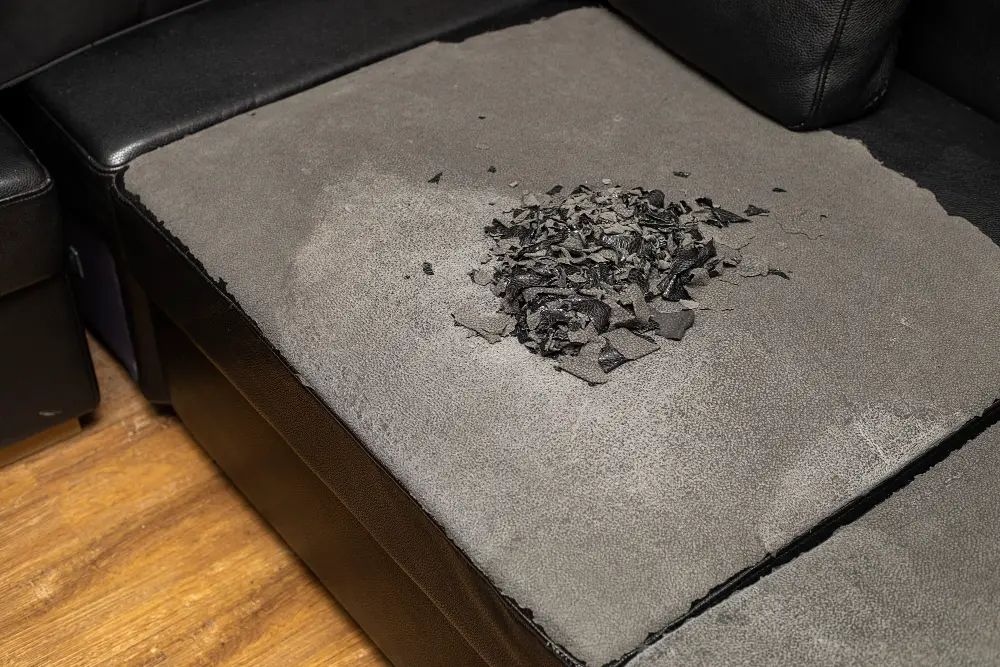Last updated on
Learn how to effectively repair bonded leather and restore your furniture to its former glory with practical tips and techniques.
Key takeaways:
- Bonded leather peels due to contact, heat, and low humidity.
- Bonded leather contains only 10-20% actual leather.
- Proper care and maintenance can prevent peeling and cracking.
- Repair small peeling areas with a leather repair kit or adhesive-backed patches.
- Spot quality leather by examining the grain pattern, texture, smell, and price.
Table of Contents
Bonded Leather Peeling Causes
Bonded leather, often referred to as faux leather, is susceptible to peeling due to its composition – it’s made from shredded leather scraps and polyurethane binder. Over time, exposure to body oils, perspiration, and heat can break down these binders, leading to peeling.
Another factor is the level of use; furniture in frequently used areas, such as living rooms, tends to peel sooner due to constant contact and friction. Frequent exposure to sunlight and heat sources can also accelerate the degradation process, drying out the material and making it brittle.
Low humidity environments might contribute to peeling as well, as they can sap moisture from the bonded leather, reducing its flexibility and resilience.
What Is Bonded Leather?
Bonded leather, often marketed as genuine leather, is actually a mix of shredded leather scraps and fibers bound with a polyurethane or latex binder. These components are then coated onto a backing and embossed to mimic the texture of full-grain leather. Typically, it contains only 10-20% actual leather.
Affordable and versatile, bonded leather is a go-to for many furniture manufacturers looking to create the look and feel of leather without the high cost. However, this affordability comes with a trade-off in durability and longevity, with bonded leather being more prone to peeling and wear over time compared to its full-grain counterpart.
Maintenance and Prevention
Caring for bonded leather properly can extend its lifespan and help prevent peeling and cracking. Regularly dust the surface with a soft cloth to avoid dirt accumulation that can cause abrasion. For deeper cleaning, use a damp cloth with mild soap, wiping gently without saturating the material. Always avoid harsh chemicals or abrasive cleaners that can strip the leather’s protective coating.
Conditioning bonded leather is vital. Do this every 6 to 12 months using a product specifically designed for bonded leather to maintain its flexibility and prevent drying out. Keep furniture away from direct heat sources and out of prolonged sunlight as these can contribute to the deterioration of the bonded leather. Mitigate excess wear and tear by using throws or blankets in high-use areas. Being proactive in the care of bonded leather furniture will pay off in the longevity of its appearance and functionality.
Bonded Leather Peeling Repair
Small peeling areas can often be mended with a leather repair kit, which includes a compound that, when dried, resembles the look and feel of leather. Follow the kit’s instructions carefully — typically, you’ll apply the compound to the area, allow it to dry and then sand it down lightly.
For more extensive damage, adhesive-backed patches can be used. These patches should ideally match the color of your bonded leather. You place the patch over the tear, ensuring it’s smooth and properly adhered to prevent further peeling.
Color restoration creams are available to blend repair work with the original color of the furniture. Apply a small amount and buff it out to ensure a uniform appearance.
Be mindful that many leather repair products are designed for genuine leather and may not adhere well to bonded leather’s synthetic components. Always check the compatibility of your repair solutions with bonded leather to avoid worsening the damage.
Hydration is key to preserving the repair and the surrounding area. Regularly conditioning can keep the leather supple, reducing the likelihood of future peeling. Use a conditioner specifically designed for bonded leather.
Sometimes professional repair is the best course of action, especially if the peeling is widespread or in a highly visible location. Professionals have access to higher-grade tools and materials that may result in a more durable and aesthetically pleasing repair.
How to Spot Quality Leather
Quality leather is characterized by its durability and texture. Full-grain leather, which includes all the natural grain, is the highest quality you’ll find. Look for inconsistencies in the grain pattern, which are a natural feature of genuine leather. High-quality leather will also age well over time, developing a patina that adds to its appeal.
When assessing leather, feel the texture. It should be supple and natural to the touch, not overly plastic or artificial. Another indicator is the edges of the furniture; genuine leather will have rough edges, whereas bonded leather or faux alternatives are usually perfectly smooth.
Smell can also be a telltale sign. Real leather has a distinct scent that cannot be replicated by synthetic materials. If the product lacks this smell or has a chemical odor, it’s likely not genuine.
Finally, consider the price. Genuine, high-quality leather typically carries a higher price tag due to its longevity and the more intensive manufacturing process. If the deal seems too good to be true, it probably is.
You may also like to read:


